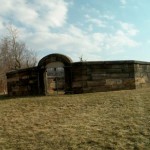 I grew up on this road named after the Stonewall Cemetery, And ended up living in the farm house less than 1/4 behind it. We had a blast as children playing here and even more parking here as a teen.
I grew up on this road named after the Stonewall Cemetery, And ended up living in the farm house less than 1/4 behind it. We had a blast as children playing here and even more parking here as a teen.
There are several legends and myths about this place, So I thought I would post some history about it. Stonewall Cemetery is located on Stonewall Cemetery Road, about  ½ mile from US-22, outside Lancaster, Ohio (Hocking Township, Fairfield County). The coordinates are 39° 41′ 28.55″ N, 82° 38′ 22.9″ W. Stonewall Cemetery a small family cemetery that is no longer active. It is maintained by the Fairfield County Historical Parks. The cemetery is kept locked to prevent vandalism. The inscription above the gate gives some history about the cemetery. It reads:
Read the reast of this artical: More
THIS WALL
which encloses the family burying ground of
of NATHANIAL WILSON (one of the early Pioneers of
the West who emigrated from Cumberland County Pa and settled
near this place A.D. 1798 when all around was one continued & uninhabited
wilderness) was commenced by him A.D. 1838 & finished in the following year
by his son GUSTIN the former having suddenly died May 12 1839
The technique used to construct Stonewall Cemetery is amazing. The angles in the wall were cut into each individual stone. This is a one of a kind cemetery, there is not another one like it anywhere.
The Fairfield County parks ordered the Lebanon cedar that is planted inside. These trees are very difficult to find, this one replaced the original one.
I was told that the entrance faces the Polaris. The North star is exactly over the arch. I was able to confirm this after many late night walks around it inside and out. The cemetery is also known to be haunted. Legend has it that if you walk around the top of the cemetery’s wall thirteen times at night flames will shoot up and you’ll be pulled into hell! I never seen any of this for myself, But many others claim all kinds of odd going’s on. Although one of my step daughters friends was there one night and was holding onto the gate and she leaned forward causing the gate to pinch one of Her fingers almost off.
If you look close at the picture below you can see the Farm house I lived in after I was married. The Tombstones have been vandalized many times over but still remain.
Also known as the Wilson Family Cemetery and the President’s Burying Ground, this unique cemetery was founded in 1817. As early pioneers to Fairfield County, where the cemetery is located, Nathaniel Wilson and his son Gustin built the wall surrounding their family plot in 1838-39. It is the only structure of it’s kind in the world, constructed by black-hand sandstone and every angle cut into the stone.
Polaris. Nathaniel Wilson III willed the cemetery to President James Monroe and all future Presidents, so George W. Bush is the current owner. The cemetery cannot be transferred to anyone else, even though no Presidents have never been buried at the site.
Nathaniel Wilson II, a Scotsman, brought his family to this area, probably over the nearby Zane’s Trace. He settled in Hocking Township in 1798. The background of this pioneer shows that his father, the first Nathaniel Wilson, was born in 1660. He and a Richard Cameron were taken prisoner by Charles I of England at the Battle of Bothwell Bridge in Lanarkshire, Scotland in 1679. Cameron’s hands were cut off, but Nathaniel, then 19, managed to escape with Cameron’s now useless sword.
He made his way home and eventually reached Cumberland County, Pennsylvania. He reared his family there and died in 1753, at age 93, leaving the Cameron sword and old Scotch Bible to his eldest son,
Nathaniel II. This Nathaniel Wilson II immigrated to the Ohio wilderness and built a humble log cabin in a clearing, and hung the old Cameron sword over its doorway in the living room. Beneath the sword were inscribed the words: “The sword of the Lord and Gideon.”
Mr. Wilson embraced the ideas and peculiarities of the Old Scoth Covenanters, among which was a great reverence and respect for the dead. Others on this frontier did not seem to share his same ideals; therefore, he envisioned something special for his family. Wilson II died on March 21, 1814, and was buried in the old city graveyard at High and Chestnut in Lancaster.
His son, Nathaniel Wilson III, inherited his father’s reverence for the dead. He finished the paperwork, and before deeding it to the president, had neighboring settlers Samuel and Emanuel Carpenter lay out a plan for enclosing it with a stone wall in 1816.
There were nine marked graves in the little cemetery. The remains of Nathaniel Wilson II and his wife Elizabeth were moved to Stonewall Cemetery and placed in unmarked graves when the old city cemetery was moved in 1907.
On July 5, 1961, James M. Hengst, Nathaniel Wilson II’s great-great grandson, purchased 1.046 acres surrounding and including the cemetery. In 1966, the cemetery was transferred to the Fairfield Heritage Association. In 1978 Heritage had it restored with a public preview on Oct. 8. 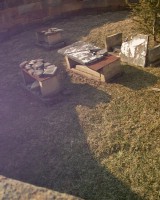
However, vandals hit several times in the 1980s and destroyed many of the stones. It was cared for by the Hocking Township Trustees for a time and is now preserved as a Fairfield County Historical Park
The wall wasn’t started until 1838. The sandstone probably came from a quarry on nearby Allen’s Knob in Shallenberger State Nature Preserve. The stones, about 18 inches thick, were shaped at the quarry to fit each into the other. At the corners, the stones were shaped with angles, thus avoiding mortar. Each of the 12 sides is 29.5 feet in length.
The wall stands today without a crack and with no settling. It is considered to be the finest example of dry masonry in the state of Ohio. At the quarry and the cemetery, Nathaniel III read to the workman from his Bible. According to I Kings 6:7, Solomon’s temple was “built of stone made ready before it was brought thither so that there was neither hammer nor ax nor any tool of iron heard in the house while it was in building.” Stonewall Cemetery was built in the same manner.
Pockets in the tops of the wall indicate that an iron fence was planned, but never constructed. The stone work of the wall included an arch over an iron gate forming the cemetery entrance. Over the north-facing gate a semicircle of smooth stone, different from that in the wall, is fitted into the arch, In the center of this plot Nathaniel planted a Cedar of Lebanon tree which he obtained from Mt. Lebanon in the Middle East.
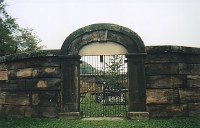
The founder’s plan for the graves is outlined in his will. His wife was to be north and his own south of the Cedar. Over each grave is a sandstone slab, and at either end is an upright stone, slightly higher at the head supporting the inscribed marble slab at a slight angle. The inscribed stones are all about 20 inches above ground level. The little cemetery has seen much in its many years and the passage of time has not been kind. Lightning struck the Cedar, and that is why it was replaced by a new Cedar of Lebanon. Take a ride out 22 west from Lancaster and have a look at it for your self, It’s worth the trip. There are more photos here
Highdef Video

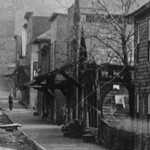
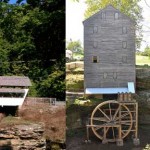
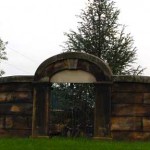
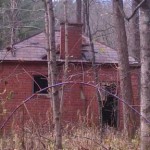
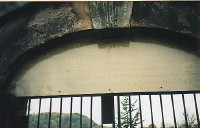
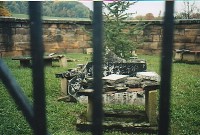
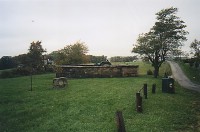
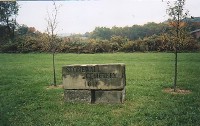

.jpg)
.jpg)
.jpg)
.jpg)
.jpg)
.jpg)
.jpg)
.jpg)
.jpg)
.gif)
.jpg)
.jpg)
.jpg)
.jpg)


Follow me on Social Media